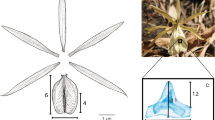Abstract
Morphometric analysis, the study of measurements of size and shape, has the potential to be an effective tool for phytolith analysis. This study reports the first attempt to apply the methodology to oats. In particular, this study was designed to determine if morphometric analysis could adequately discriminate between phytoliths produced in the inflorescence bracts of two species of oats, Avena sativa L. and Avena strigosa Schreb. Results indicate that while the taxa produce the same types of phytoliths, those phytoliths have significantly different measurements of size and shape. This suggests the technique has the potential to become a powerful research tool for investigators working in the wide variety of disciplines that utilize phytolith analysis.
Similar content being viewed by others
Literature Cited
Aston, M. J., and M.M. Jones. 1976. A study of the transpiration surfaces ofAvena sterilis L. var. Algerian leaves using monosilicic acid as a tracer for water movement. Planta 130(2):121–9.
Baker, G. 1959. Hook-shaped opal phytoliths in the epidermal cells of oats. Australian Journal of Botany 8:69–74.
Ball, T.B., J. S. Gardner, and N. Anderson. 1999. Identifying inflorescence phytoliths from selected species of wheat (Triticum monoccum, T. dicoc-con, T. dicoccoides, andT. aestivum) and barley (Hordeum vulgare andH. spontaneum). American Journal of Botany 86(11): 1615–1623.
Bennett, D.M. 1982. Silicon deposition in the roots ofHordeum sativum, Avena sativa L. andTriticum aestivum L. Annals of Botany 50(2):239–246.
Berlin, A.M., T.B. Ball, R. Thompson, D. Kittleson, and S.C. Herbert. 2003. Ptolemaic agriculture, “Syrian wheat,“ andTriticum aestivum. Journal of Archaeological Science 30:115–121.
Dennell, R.W. 1992. The origins of agriculture in Europe. Pages 71–100 in C. Wesley Cowan and Patty Jo Watson, eds. The origins of agriculture: An international perspective. Smithsonian Institution Press, Washington, D.C.
Harlan, J.R. 1992. Indigenous African agriculture. Pages 59–70 in C. Wesley Cowan and Patty Jo Watson, eds. The origins of agriculture: An inter-national perspective. Smithsonian Institution Press, Washington, D.C.
Hodson, M.J., P.J. White, A. Mead, and M.R. Broadley. (Accepted, n.d.). Phylogenetic variation in the silicon composition of plants. Annals of Botany.
Jones, L.H.P., A. A. Milne, and S.M. Wadham. 1963. Studies of silica in the oat plant II. Distribution of the silica in the plant. Plant and Soil 18(3):358–371.
— and K. A. Handreck. 1965. Studies of silica in the oat plant III. Uptake of silica from soils by the plant. Plant and Soil 23(1):79–96.
Kaplan, L., M.B. Smith, and L.A. Sneddon. 1992. Cereal grain phytoliths of Southwest Asia and Europe. Pages 149–174 in G. Rapp and S.C. Mulholland, eds. Phytolith systematics. Plenum Press, New York and London.
Kaufman, P.B., W.C. Bigelow, L.B. Petering, and F.B. Drogosz. 1969. Silica in developing epider mis cells ofAvena internodes: Electron micro-probe analysis. Science 166:1015–1017.
Madella, M., A. Alexandre, and T. Ball. 2005. Inter national code for phytolith nomenclature 1.0. An nals of Botany 10.1093/aob/mcil72.
Pearsall, D.M., D.R. Piperno, E.H. Dinan, M. Um-lauf, Z. Zhao, and R. A. Benefer, Jr. 1995. Distinguishing rice (Oryza sativa Poaceae) from wildOryza species through phytolith analysis: Results of preliminary research. Economic Botany 49:183–196.
Soni, S.L., P.B. Kaufman, and W.C. Bigelow. 1971. Electron microprobe analysis of the distribution of silicon in leaf epidermal cells of the oat plant. Phytomorphology 20:350–363.
—, P.B. Kaufman, and W.C. Bigelow. 1972. Regulation of silicon deposition inAvena inter-nodal epidermis by gibberellic acid and sucrose. Journal of Experimental Botany 23(76):787–791.
Weibul, J., L.L.J. Bojesen, and V. Rasomavièvius. 2002.Avena strigosa in Denmark and Lithuania: Prospects for in situ conservation. Plant Genetic Resources Newsletter 131:1–6.
Zhao, Z., D.M. Pearsall, A.B. Benefe, Jr., and D.R. Piperno. 1998. Distinguishing rice (Oryza sativa Poaceae) from wildOryza species through phy-tolith analysis, II: Finalized method. Economic Botany 52:134–135.
Zhou, X., E.N. Jellen, and J.P. Murphy. 1999. Pro-genitor germplasm of domesticated hexaploid oat. Crop Science 39(4):1208–1214.
Author information
Authors and Affiliations
Corresponding authors
Rights and permissions
About this article
Cite this article
Portillo, M., Ball, T. & Manwaring, J. Morphometric analysis of inflorescence phytoliths produced byAvena sativa L. andAvena strigos schreb. Econ Bot 60, 121–129 (2006). https://doi.org/10.1663/0013-0001(2006)60[121:MAOIPP]2.0.CO;2
Received:
Accepted:
Issue Date:
DOI: https://doi.org/10.1663/0013-0001(2006)60[121:MAOIPP]2.0.CO;2




